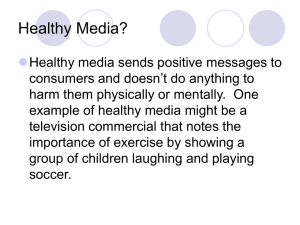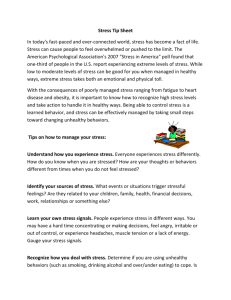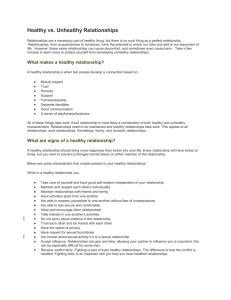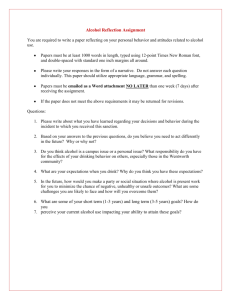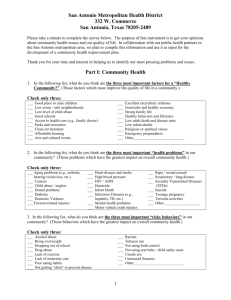The Influence of the Media on Food Consumption and Body... Katie Belitz and Anthony Frank
advertisement
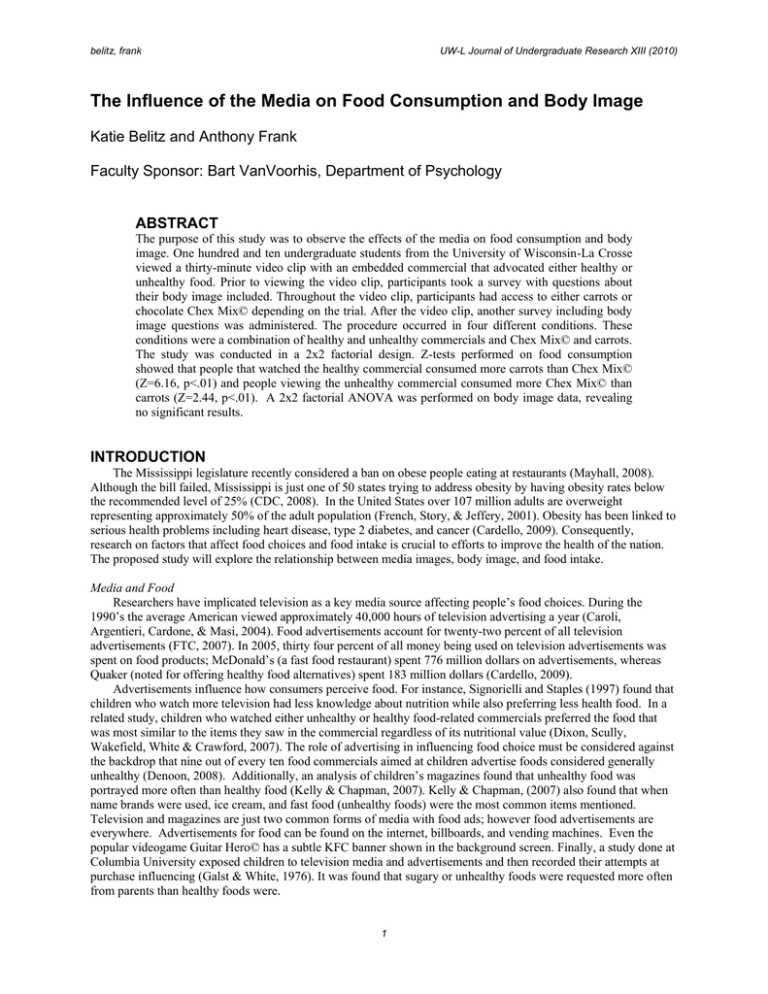
belitz, frank UW-L Journal of Undergraduate Research XIII (2010) The Influence of the Media on Food Consumption and Body Image Katie Belitz and Anthony Frank Faculty Sponsor: Bart VanVoorhis, Department of Psychology ABSTRACT The purpose of this study was to observe the effects of the media on food consumption and body image. One hundred and ten undergraduate students from the University of Wisconsin-La Crosse viewed a thirty-minute video clip with an embedded commercial that advocated either healthy or unhealthy food. Prior to viewing the video clip, participants took a survey with questions about their body image included. Throughout the video clip, participants had access to either carrots or chocolate Chex Mix© depending on the trial. After the video clip, another survey including body image questions was administered. The procedure occurred in four different conditions. These conditions were a combination of healthy and unhealthy commercials and Chex Mix© and carrots. The study was conducted in a 2x2 factorial design. Z-tests performed on food consumption showed that people that watched the healthy commercial consumed more carrots than Chex Mix© (Z=6.16, p<.01) and people viewing the unhealthy commercial consumed more Chex Mix© than carrots (Z=2.44, p<.01). A 2x2 factorial ANOVA was performed on body image data, revealing no significant results. INTRODUCTION The Mississippi legislature recently considered a ban on obese people eating at restaurants (Mayhall, 2008). Although the bill failed, Mississippi is just one of 50 states trying to address obesity by having obesity rates below the recommended level of 25% (CDC, 2008). In the United States over 107 million adults are overweight representing approximately 50% of the adult population (French, Story, & Jeffery, 2001). Obesity has been linked to serious health problems including heart disease, type 2 diabetes, and cancer (Cardello, 2009). Consequently, research on factors that affect food choices and food intake is crucial to efforts to improve the health of the nation. The proposed study will explore the relationship between media images, body image, and food intake. Media and Food Researchers have implicated television as a key media source affecting people’s food choices. During the 1990’s the average American viewed approximately 40,000 hours of television advertising a year (Caroli, Argentieri, Cardone, & Masi, 2004). Food advertisements account for twenty-two percent of all television advertisements (FTC, 2007). In 2005, thirty four percent of all money being used on television advertisements was spent on food products; McDonald’s (a fast food restaurant) spent 776 million dollars on advertisements, whereas Quaker (noted for offering healthy food alternatives) spent 183 million dollars (Cardello, 2009). Advertisements influence how consumers perceive food. For instance, Signorielli and Staples (1997) found that children who watch more television had less knowledge about nutrition while also preferring less health food. In a related study, children who watched either unhealthy or healthy food-related commercials preferred the food that was most similar to the items they saw in the commercial regardless of its nutritional value (Dixon, Scully, Wakefield, White & Crawford, 2007). The role of advertising in influencing food choice must be considered against the backdrop that nine out of every ten food commercials aimed at children advertise foods considered generally unhealthy (Denoon, 2008). Additionally, an analysis of children’s magazines found that unhealthy food was portrayed more often than healthy food (Kelly & Chapman, 2007). Kelly & Chapman, (2007) also found that when name brands were used, ice cream, and fast food (unhealthy foods) were the most common items mentioned. Television and magazines are just two common forms of media with food ads; however food advertisements are everywhere. Advertisements for food can be found on the internet, billboards, and vending machines. Even the popular videogame Guitar Hero© has a subtle KFC banner shown in the background screen. Finally, a study done at Columbia University exposed children to television media and advertisements and then recorded their attempts at purchase influencing (Galst & White, 1976). It was found that sugary or unhealthy foods were requested more often from parents than healthy foods were. 1 belitz, frank UW-L Journal of Undergraduate Research XIII (2010) Even without media as an influence people appear to prefer unhealthy foods over healthy foods. Vegetables and fruits, while rich in vitamins and nutrients, are seen as tasteless, boring and dated, whereas unhealthy foods are requested more often for meal options at restaurants (Pollard, Clark, & Cade, 2002; Galst & White, 1976). In addition, children who prefer unhealthy food actually consume more of it, as measured by a food intake check sheet, than do children who prefer more healthy food (Dixon, Scully, Wakefield, White, & Crawford, 2007). Media, Body Image and Food Intake The images shown in the media often portray an unrealistic version of what people actually look like. Images are airbrushed and manipulated to make a person look more desirable so that even “perfect” models are made to be more flawless and the ideal less obtainable. Meta-analyses show that thin-bodied images presented in the media have been shown to be related to body dissatisfaction among both men and women (Barlett, Vowels, & Saucier, 2008; Grabe, Ward, & Hyde, 2008). These images may trigger people to consciously think about their own bodies. Verplanken and Velsvik (2008) found that habitually thinking negative thoughts about one’s body image was related to greater body dissatisfaction and body image disturbances. As illustrated above, the media affects the kinds of food people eat. In addition, both the amount and type of food that people eat can have an impact on their reported body image. Vocks, Legenbauer, and Heil (2007) found recent food intake had a negative effect on a self-report of body image and increased the level of body dissatisfaction. Participants who showed stronger patterns of restrained eating made a larger estimate of their body size. In another study dealing with eating restraint, Joshi and Polivy (2004) had participants view a magazine advertisement of either a thin model or a neutral item. The participants were categorized as either restrained or unrestrained eaters. Restrained eaters (people who actively attend to food choice) reported a lower self-image and self-esteem than unrestrained eaters. People who tend to be concerned with how much they eat feel worse about themselves after viewing images in the media. Given the established association between the media and body image, and the media and food intake, the current study attempted to more fully elaborate the relationships among these key variables. It was expected that people who watch unhealthy food-related television advertisements would consume more food (healthy and unhealthy) than those who watch healthy advertisements. People who watched healthy advertisements and eat an unhealthy snack would have the lowest body image. People who watched a clip with healthy advertisements and who are offered a healthy snack would have the highest body image out of the four conditions. As a whole, people who consumed more food regardless of the advertisement would have a lower body image than those who eat less food. METHOD One hundred and twenty undergraduate students from the University of Wisconsin-La Crosse participated in this study. The students ranged from 18 and 25 years old. Participants resided in the United States for the past five years in order to select students with potentially similar media habits. This study did not include participants with food allergies. After obtaining informed consent from the participants the researchers provided the participants with a questionnaire containing a body image inventory, and several obfuscating measures, and standard demographic questions. After completing the questionnaire, participants viewed a video with neutral content without any foodrelated context. Participants were randomly assigned to a condition where they where they watched a video with a 30 second commercial in the middle for either unhealthy food or healthy foods. During the video, a healthy or unhealthy snack was prominently available. The snacks were pre-weighed in order to accurately assess the level of food intake. Once the video was finished, the participants completed a second questionnaire. The questionnaire contained the same body image questionnaire as in the first questionnaire in order to measure any changes in body image. The remaining components of the questionnaire included measures aimed at masking the purpose of the study such as measures evaluating the video stimulus. At the end of each session the participant groups were debriefed on the experiment and the purpose of being deceived in the experiment was made clear to them. The researchers then weighed the pre-measured bowls as a whole to see how much food was consumed per group. Data Analysis and Dissemination This study is a 2 X 2 factorial design with two independent variables with two levels each – commercial (healthy food or unhealthy food) and type of food available (healthy or unhealthy). The dependent variables are change in body image and food intake. ANOVA analyses were used to test the hypotheses. 2 belitz, frank UW-L Journal of Undergraduate Research XIII (2010) RESULTS Two 2X2 factorial ANOVAS, one for each of the body image questions, were conducted to measure the difference score of the body image questions compared to commercial type and snack type. No significant means or interactions were shown for either question, as shown in Table 1 and Table 2. Table 1. Difference Score Question One F-Value Significance 0.009 0.923 Video 0.159 0.691 Snack 0.930 Video*Snack 0.008 Table 2. Difference Score Question Two F-Value Significance 1.354 0.247 Video 2.580 0.111 Snack 2.580 0.111 Video*Snack Z-Tests were used to compare the proportions of food consumed in the four conditions (Table 3). People that viewed a healthy commercial ate more carrots than Chex Mix© (Z=6.16, p<.01). People that viewed an unhealthy commercial ate more Chex Mix© than carrots (Z=2.44, p<.01). People ate more Chex Mix© when viewing an unhealthy commercial than when viewing a healthy commercial (Z=4.61, p<.01). People that were offered carrots ate more when viewing a healthy commercial than when viewing an unhealthy commercial (Z=4.43, p<.01). Figures 1, 2, 3, and 4 show these effects. Table 3. Group proportion of food consumption (ounces) Chex Mix© Carrots 11.2 68.45 Healthy Commercial 72.3 108.1 40.1 62.45 Unhealthy Commercial 76.6 176.35 3 belitz, frank UW-L Journal of Undergraduate Research XIII (2010) Figure 1. Amount of food consumed in the Chex Mix© and healthy commercial condition Figure 2. Amount of food consumed in the Chex Mix© and unhealthy commercial condition 4 belitz, frank UW-L Journal of Undergraduate Research XIII (2010) Figure 3. Amount of food consumed in the carrots and healthy commercial condition Figure 4. Amount of food consumed in the carrots and unhealthy commercial condition DISCUSSION There were no results found for body image. This could be cause by a potential type two error. It is possible that these questions were not sensitive enough. It is also possible that only two questions may have not been enough to pick up any significant differences. It could also be possible that the commercial type and snack type really had no impact on body image. Further research is needed to see what roles these variables have in relation to body image. It is difficult to have two sets of the same body image questions embedded into a survey without revealing the purpose of these questions. Perhaps using a scale with more items or making sure that the scale had more points would have seen different results. As hypothesized, this research found that people ate more food (healthy and unhealthy) when viewing unhealthy food advertisements. With this and America’s current obesity epidemic in mind, it would be very beneficial for the media to feature more healthy food advertisements. This shows a direct relationship between images in the media and human behavior. Even though significant results were found for food consumption, some things need to be considered. Bowls were measured based on group consumption weight instead of by individual consumption weight. More data could 5 belitz, frank UW-L Journal of Undergraduate Research XIII (2010) have been analyzed by using individual consumption differences rather than just group consumption differences. Another factor to consider regarding food consumption is how much noise the food made. Both carrots and Chex Mix© are crunchy foods and some participants may have viewed their chewing as distracting and possibly limiting the amount of food they consumed. Further research is needed to determine whether this effect happens more often at a certain time of day or if the amount of television a person is exposed to have any influence on how much food they consume. Overall this area of research is needed to better understand nutrition and eating habits. REFERENCES Barlett, C., Vowels, C., & Saucier, D. (2008). Meta-analyses of the effects of media images on men's body-image concerns. Journal of Social and Clinical Psychology, 27(3), 279-310. Cardello, H. (2009). Stuffed: An insider’s look at who’s (really) making America fat. Echo, NYC. Caroli, M., Argentieri, L., Cardone, M., & Masi, A. (2004). Role of television in childhood obesity prevention. International Journal of Obesity, 28, 104-108. Center for Disease Control. (2008). Overweight and Obesity. Retrieved Feb. 23, 2009. http://www.cdc.gov/obesity/ DeNoon, D.J. (2008). Saturday Morning Ads for kids sell fats, Salts, Sugar, Low Nutrition. WebMD Health News. Retrieved Feb. 23, 2009. http://www.medicinenet.com/script/main/art.asp?articlekey=88332 Dixon, H., Scully, M., Wakefield, M., White, W., Crawford, D. (2007), "The effects of television advertisements for junk food versus nutritious food on children's good attitudes and preferences", Social Science and Medicine, 6513. Federal Trade Commission. (2007). Weighing in: Marketing, regulation and childhood obesity. Department of Health and Human Services. For the record, Inc. Washington, D.C. French, S.A., Story, M., and Jeffery, R.W. (2001). Environmental influences of eating and physical activity. Annual Rev Public Health: 22, 309-35. Galst, J. P., and White, M.A. (1976). The unhealthy persuader: The reinforcing value of television and children’s purchase-influencing attempts at the supermarket. Child Development, 47. Grabe, S., Ward, L., & Hyde, J. (2008). The role of the media in body image concerns among women: A metaanalysis of experimental and correlational studies. Psychological Bulletin, 134(3), 460-476. Joshi, R., Herman, C., & Polivy, J. (2004). Self-Enhancing Effects of Exposure to Thin-Body Images. International Journal of Eating Disorders, 35(3), 333-341. Kelly, B. & Chapman, K. (2007). Food references and marketing to children in Australian magazines: A content analysis. Health Promotion International, 22 (4), 284-291. Mayhall, W.T. (2008). House Bill 282. Mississippi Legislature: 2008 Regular Session. Pollard, J., Kirk, S.L., Cade, J.E. (2002). Factors affecting food choice in relation to fruit and vegetable intake: a review. Nutritional Research Reviews: 15, 373-387. Signorielli, N. and Staples, J. (1997). Television and children’s conceptions of nutrition. Health Communication, 9 (4), 289-301. Verplanken, B., & Velsvik, R. (2008). Habitual negative body image thinking as psychological risk factor in adolescents. Body Image, 5(2), 133-140 Vocks, S., Legenbauer, T., & Heil, A. (2007). Food intake affects state body image: Impact of restrained eating patterns and concerns about eating, weight and shape. Appetite, 49(2), 467-475. 6

